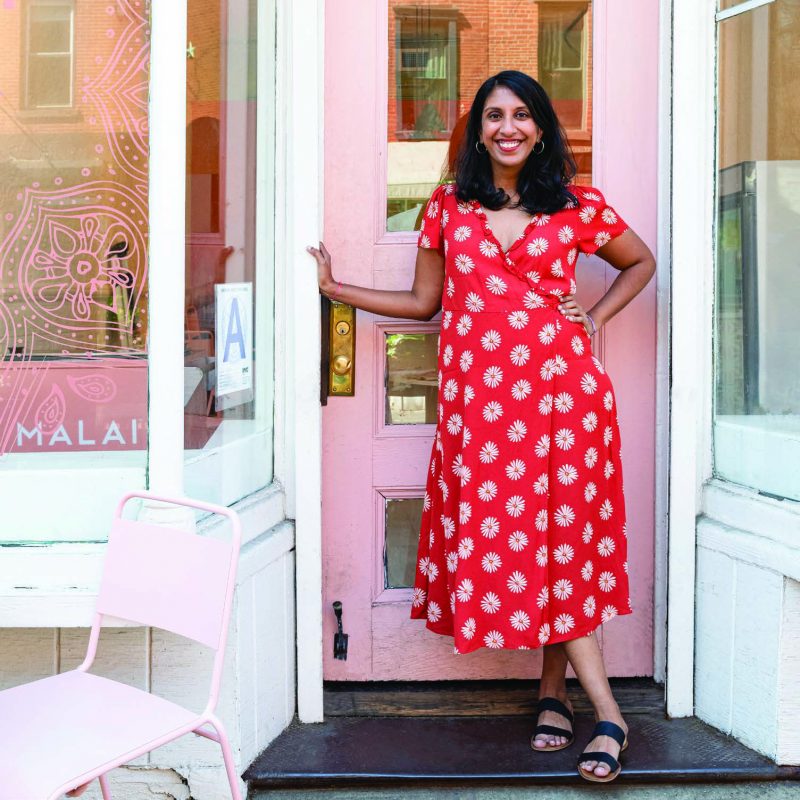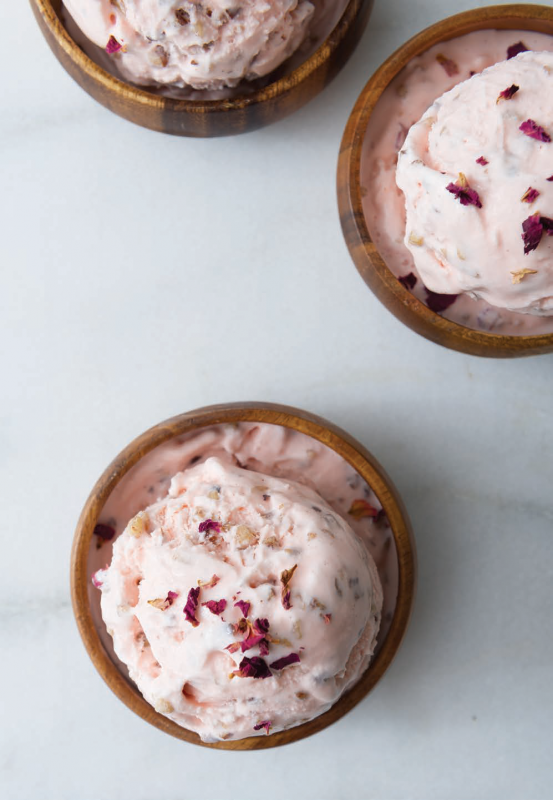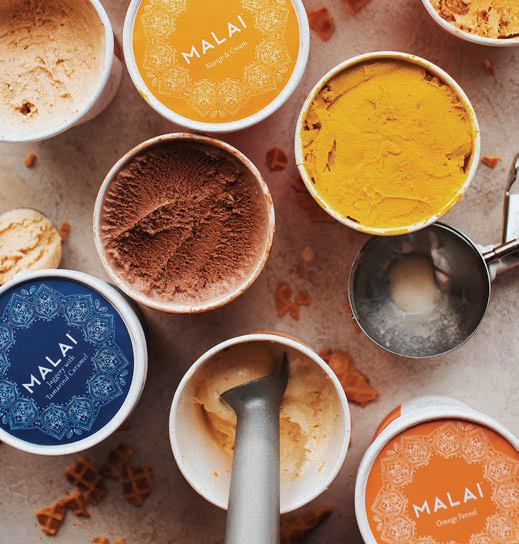This article originally appeared in the Spring 2022 print issue of Quench Magazine.
To experience Brooklyn-based Malai Ice Cream is to be transported to the nostalgic flavors of India that Pooja Bavishi grew up with. Partake in her stories in which ice cream with flavors such as agate candy saffron, jaggery with tamarind caramel, and sweet roti and ghee is the medium and delight your senses with a “decadent blend of cream and culture.”
As a first generation Indian American, her creations are inspired by nostalgic childhood flavors, cultural heritage, and her family’s food traditions. Growing up in ‘90s North Carolina, Bavishi was drawn to the kitchen at an early age, particularly by the sounds and aromas of her mother’s chai making each morning. At the age of 10, she remembers baking a white chocolate cheesecake for her family. “The thing that I remember most is the fact that I cut this cheesecake while it was still warm, which is the biggest no-no ever. I gave it to my parents and my sister and I can still remember, however many decades later now, that their faces lit up. They were like ‘This is so good, Pooja.’ So, I made this connection early on that if you make something with your heart and soul, it’s really going to make people happy.”
What was your inspiration for starting Malai?
My parents are immigrants from India, so Malai in Gujarati translates to “cream of the crop.” I grew up with a nostalgia for the India of my parents. I think because it was an experience that I didn’t get to feel and breathe much in the same way, or at least in a way that I was craving. My parents who were entrepreneurs themselves encouraged me to start my own business. At the time I didn’t feel that I had the business acumen, so I decided to enroll in NYU Stern School of Business.
They had gifted me an ice cream maker when I moved to New York, and it was just kind of sitting there. My sister and I always joked that growing up, whenever we moved apartment to apartment, my mom always came and stocked our kitchen – so there was always a section that we called the Indian side. It had things that, you know, allowed us to make our comfort foods. In November of 2014, I held this annual vegetarian friends-giving and made ice cream for the first time, pulling spices from there [the Indian side]. I actually think that was just these two sides of me that were finally coming together. Here I was with this concept where I always was so nostalgic for my parents’ upbringing, for India, and to tell that story of mine. And this was a perfect way for me to do it.
Why eggless ice cream?
There are two reasons for that. First, when I was tinkering with different formulas, I wanted to highlight these spices and flavors that hadn’t been present in mainstream ice cream before, and I found that the egg yolks muddled the flavors. Secondly, my parents come from a part of India where a huge portion of the population is vegetarian and they don’t consider eggs to be vegetarian. I felt strongly that I didn’t want to pull from my cultural background and then make these products inaccessible to that population. I also made the decision that everything coming out of the Malai kitchen, whether that’s our ice cream, baked goods or anything else would be eggless.
How do you develop new flavors?
It really depends, but all of these flavors are meant to tell a story. I’m not just trying to throw things together and call it Indian-inspired. I am also passionate about my heritage and culture, and very conscious when telling my story because I’m not trying to be a representative of all Indian Americans. The only story that I know in this world is mine and that is a story that I’m telling. Now, I do believe that people feel a lot of connection to my stories. I’m also very intention-al as it’s about smells, tastes, touch. All of the senses that are really active when you’ve grown up in a multicultural household.
As an example, for Diwali (which is the Indian New Year), my family makes a pastry called ghughra (it contains milk powder, sugar, nuts and cardamom). I wanted to translate that into an ice cream because it was/is such a deep-rooted part of my family’s culture. I wanted that to be really present in our Diwali offerings and so we actually make a lightly spiced cardamom ice cream and we put the ghughra filling throughout. The masala chai flavor is made with the exact same spice blend that was created by my grandmother and so that for me is very memory forward. The carrot halwa flavor is inspired by my father who enjoys carrot halwa with a scoop of vanilla ice cream, so it’s the best of both worlds.
Have people been more or less receptive to your flavors of ice cream?
I think they are really receptive. Because these are flavors that I grew up with, I wanted to make them really accessible to people. There was this cake that we developed a couple of years ago, that we call the Gulab jamun ice cream cake now. Gulab jamun is like a milk-based donut that’s soaked in a syrup. It often has flavorings of saffron, cardamom or rose. We make this eggless cake that’s saffron syrup soaked and we put our rose with cinnamon roasted almond ice cream in between the layers. It is extremely popular. But when we debuted it, we actually called it saffron syrup-soaked ice-cream cake. And then very quickly, I was like you know what, I created this based on a Gulab jamun, so we should call it a Gulab jamun ice cream cake! Our customers will come in and ask questions about what is ghughra ice cream or shrikhand frozen yogurt? And that is something I am happy to both talk about and explain, and the same goes for our team.
Has there been tension or conflict in balancing what you want to expose people to from a flavor/cultural context and what you thought people would be accepting of?
I think that our ice cream is not for everyone, and I knew that from the very beginning. I know who our audience is, and our audience knows us. They understand exactly what we’re trying to do and exactly what our brand represents. So, I don’t think that there’s a tension there.
When I first started in July of 2015, I had literally just graduated from business school and I sold my first scoop two weeks later at a street fair, pushing a chest freezer. Orange fennel was one of my first flavors that I created.
This woman bought a scoop and then walked away, and then I saw her kind of do a complete 180 and walk back towards me. I’m not exaggerating when I say that I pulled the cash back out of the cash drawer and prepared to hand it to her because I was sure that she hated it. Instead, she came back and said “I just want to let you know that my Italian grandmother used to make orange and anise cookies, and I haven’t had this flavor since she’s passed. I just wanted to thank you.” That was one of my very first [business] memo-ries and an embodiment of what we’re trying to do at Malai.
Is your business seasonal or do people line up for your ice cream all year round?
Ice cream is always a little seasonal, with our first quarter being the slowest. At the moment, we only have the one store in Brooklyn, but we also sell to grocery stores and our shipping part of the business really took off due to the pandemic. I will add that as a business owner, and as a person, it [the pandemic] taught me a lesson in resilience and grit in a way that I hadn’t experienced before. It also showed me how strong this community of food businesses and food entrepreneurs really is. I definitely felt the support.
What can we expect from you next?
There are some exciting things in the future, so stay tuned. The one thing I can say, is that we want to expand and develop Malai as a global brand. I love the idea of getting Malai to as many people as possible.

Rose with cinnamon roasted almonds ice cream
Photo credit: Morgan Ione Yeager
Photo credit: supplied
MALAI ICE CREAM SIGNATURE COLLECTION
These signature collection ice creams are eggless (therefore not made from a custard base), but not vegan. While the mouthfeel may not be as luxurious, it doesn’t detract at all from the sensorial experience.
Rose with Cinnamon Roasted Almonds: One of Malai’s most popular flavors, and for good reason. The floral notes are balanced with an unexpected but welcome variance in texture from the cinnamon roasted almonds, making this a most delectable sensorial experience.
Orange Fennel: Fennel seeds are ubiquitous in Indian cuisines and are often served as a digestive. With this ice cream, the anise-like flavor of the fennel is tempered by the citrus to produce a bright, zesty-yet-light flavor with a delightful crunch from the seeds that is reminiscent of a beautiful spring day.
Mango & Cream: This ice cream conjures memories of eating a ripe mango with the juices dripping down one’s arm in a tropical climate that is pure sunshine. A combination of tart and sweet with a creamy finish, it is sure to delight the palate.
Masala Chai:If you have ever wanted to experience chai in ice cream form, well here’s your chance. A masala spice blend that be-longed to Pooja’s mother is used to create that all too familiar feeling of the warmth and spiciness that is characteristic of chai. It has a finish with notes of cinnamon, cardamom and ginger that linger leaving you wanting more, for the joys of chai drinking are beautifully captured here.
Neema Syovata is a food writer, researcher, and photographer, who lives in an idyllic hamlet in the northeastern USA, by way of Nairobi, Kenya. She is obsessed with all things food and spends a lot of time thinking about the future of modern African cuisine and, also, how to create a more inclusive space for BIPOC to tell their culinary stories. She recently completed her Master’s degree in Gastronomy from Boston University to aid in that goal. In her spare time, she can be found backyard foraging, conducting culinary experiments, and drinking lots of chai.
Feature Photo credit: Morgan Ione Yeager



